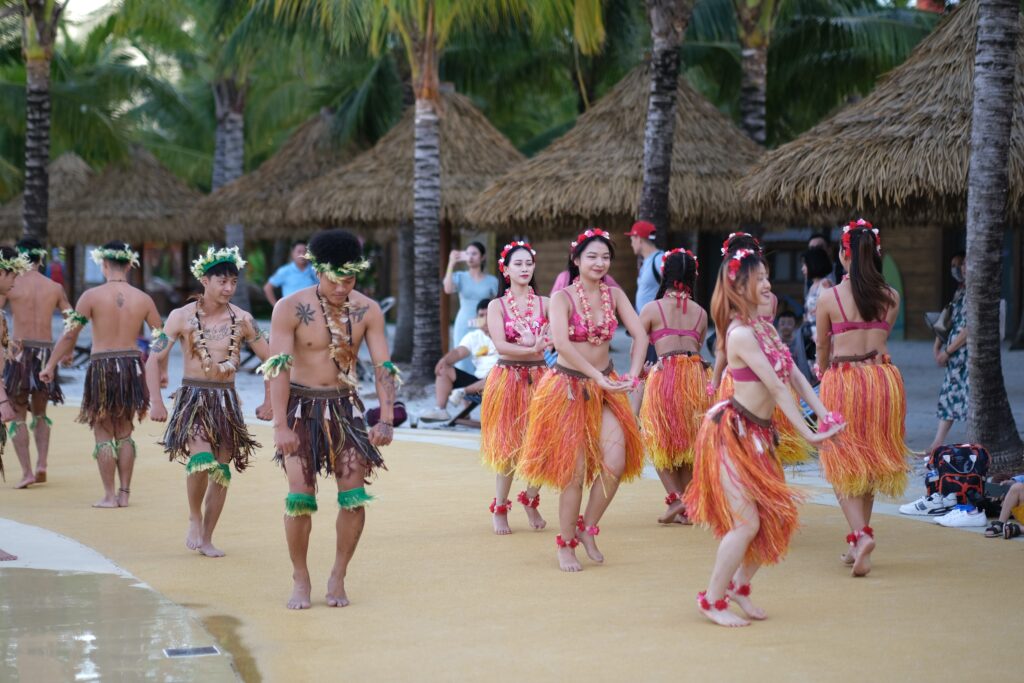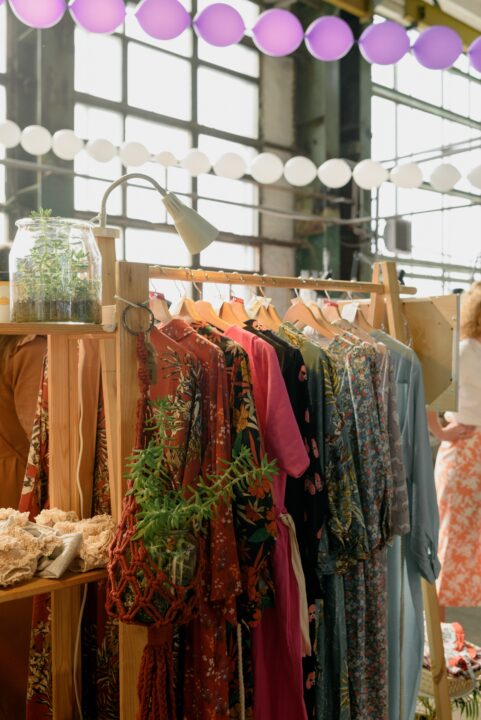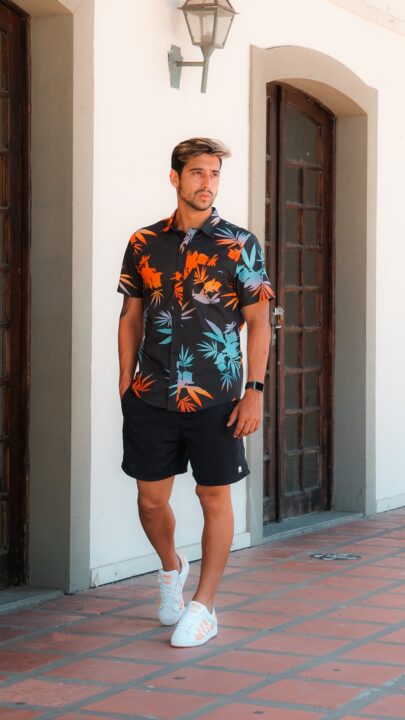Hawaii, a beautiful and unique place, is not just known for its stunning landscapes but also for its special traditional clothing. These clothes have a long history and are an important part of Hawaiian culture.
In this article, we will explore ten traditional Hawaiian clothing, each with its own story and meaning. From the elegant Holoku to the colorful Aloha shirt, these garments show the spirit and style of the Hawaiian Islands.
Let’s dive into the world of Hawaiian fashion and discover the beauty of these outfits already!
Ten Hawaiian Traditional Clothing
1.The Holoku
-

ksenia chernaya,pexels,15170528.jpg
It is a special dress from Hawaii. It is a bit different from what you might wear every day. This dress is known for its elegant and flowing style. It is a dress with long sleeves and a high neckline. It is quite formal, perfect for important events. But it is not just any formal dress; it is a piece of Hawaiian culture and history.
The Holoku has a unique history. It is said to have been inspired by Victorian-era fashion, with a Hawaiian twist. This blend of styles creates a one-of-a-kind look. The dress is often made from light and breathable materials because Hawaii can be very warm. The flowy design allows air to circulate, keeping the wearer comfortable in the tropical climate.
Many women in Hawaii wear the Holoku at special occasions like weddings or hula performances. It is a way to connect with their culture and showcase its beauty. What sets the Holoku apart is its grace. When a person wearing it moves, the dress flows like the waves of the ocean. This dance of fabric adds to the charm of the Holoku.
2. Mu’umu’u
It is a lovely and comfortable dress that comes from Hawaii. It is perfect for warm and sunny days because it is loose and flowy. Mu’umu’us are known for their bright and colorful patterns, often featuring beautiful Hawaiian flowers.
These dresses are so easy to wear. They do not have a tight waist or sleeves, which makes them great for relaxing and staying cool in the Hawaiian heat. M any people wear mu’umu’us on special occasions, like luaus or family gatherings, to celebrate in style and comfort.
Mu’umu’us are loved by both local Hawaiians and visitors. They are a symbol of the relaxed and joyful Hawaiian way of life. When you put on a Mu’umu’u, you instantly feel like you are a part of the island’s laid-back spirit.
3. Aloha Shirt
-

moises ribeiro, pexels, 11030407.jpg
The Aloha shirt is a famous Hawaiian garment. It is a casual and colorful shirt with bright, eye-catching patterns, often featuring flowers, palm trees, or other tropical motifs. This shirt is a symbol of relaxation and the laid-back Hawaiian lifestyle.
People worldwide wear Aloha shirts, but they hold a special place in Hawaiian culture. They are perfect for warm weather, keeping you cool and comfortable. The shirt’s loose fit and short sleeves are ideal for the tropical climate. Aloha shirts are versatile. You can wear them to the beach, a casual dinner, or even to work on “Aloha Fridays,” when businesses encourage employees to dress in a more relaxed style. They are suitable for both men and women.
These shirts have a fascinating history. They were first created in the early 20th century by local tailors using Japanese kimono fabric. In the 1930s, they gained popularity among tourists, and by the 1950s, they became a symbol of Hawaiian tourism.
While the Aloha shirt is known for its vibrant and playful designs, it is also a cultural symbol, representing the spirit of Hawaii. When you wear one, you are not just putting on a shirt; you are showing the Aloha spirit of warmth, friendliness, and hospitality that Hawaii is known for.
It is a simple yet versatile piece of clothing that holds great importance in Hawaiian culture. It is essentially a rectangular piece of fabric, typically vibrant and colorful, often adorned with floral or Polynesian patterns.
The lava is incredibly comfortable and well-suited for the warm Hawaiian climate. Its simplicity allows for various ways of wearing it. Many people use it as a wraparound skirt, securing it at the waist with a simple knot. This makes it a popular choice for casual wear, whether you are heading to the beach, strolling through a tropical market, or just enjoying a day out in the sun.
Apart from being a practical choice, lava also carries cultural significance. It is often seen during traditional Hawaiian ceremonies and festivals. Women may wear it as part of their hula dancing attire, adding to the graceful movements and colorful spectacle of the performance.
5. The Palaka Shirt
-

porapak apichodilok, Pexels,346734.jpg
It is a classic piece of Hawaiian fashion. Its story dates back to the 19th century, when it was introduced by Portuguese immigrants who came to Hawaii to work in the sugar cane fields.
This shirt is known for its simple yet distinctive design, featuring a checkerboard pattern with bold, contrasting colors like red and white or blue and white. The pattern is not just for looks; it also served a practical purpose. In the early days, plantation workers needed durable clothing that could withstand the rigors of their labor-intensive jobs. The Palaka shirt, made from sturdy cotton fabric, fit the bill perfectly.
Over time, the Palaka shirt became associated with the paniolo, Hawaiian cowboys, who wore it as part of their everyday attire. It was not just a work shirt but a symbol of their rugged lifestyle. The shirt’s durability and comfort make it ideal for long days on horseback.
Today, the Palaka shirt is more than just workwear; it is a beloved symbol of Hawaiian heritage. It is often worn casually and has even found its way into the world of fashion.
6. Kihei
It is a traditional piece of clothing in Hawaiian culture. It is not like the shirts or dresses you might wear every day. Instead, it is more like a cape, and it holds a lot of meaning.
First, let’s talk about how it looks. Kihei is usually made from tapa cloth or kapa, which is a type of fabric made from the inner bark of certain trees. It has a unique texture and appearance, and it can be quite colorful. When someone wears a Kihei, they drape it over their shoulders like a cape.
Now, why is the Kihei important? Well, it is often worn during important ceremonies and special occasions in Hawaii. It is a symbol of honor and respect. You might see hula dancers wearing Kihei when they perform. It adds to the beauty of their dance and shows their connection to Hawaiian traditions.
In the past, Kihei was also a symbol of status. It was worn by chiefs and other important people in Hawaiian society. So, when you see someone wearing a Kihei today, it is not just a piece of clothing; it is a link to Hawaii’s history and culture.
7. Tapa Cloth
It is also known as “kapa” in Hawaiian culture. It holds a special place in the hearts of Pacific Islanders. It is not your typical fabric; instead, it is made from the inner bark of certain trees, such as the paper mulberry or breadfruit. The process of creating tapa cloth is a true art form passed down through generations.
To make tapa cloth, the bark is first stripped from the tree. Then, it is soaked, beaten, and flattened to create a thin, durable material. The resulting cloth has a unique texture, is often slightly rough to the touch, and can be surprisingly soft.
Tapa cloth is not just about practicality; it is deeply woven into the cultural fabric of the Pacific. It is used for clothing, ceremonial purposes, and even as decorative art. Each piece of tapa cloth tells a story, with intricate designs and patterns representing the traditions and stories of the people who create it.
8. The Pa’u skirt
It is a colorful piece of traditional Hawaiian clothing. It plays a significant role in hula dancing, one of Hawaii’s most famous cultural traditions. This skirt consists of multiple layers of vibrant fabric, often featuring bright floral patterns. The layers create a mesmerizing effect when dancers move, adding an extra dimension to their performances.
Pa’u skirts are more than just clothing; they are a symbol of the Hawaiian spirit and heritage. They are typically worn by female hula dancers but you can also find them in various designs for everyday wear or special occasions. When a dancer dons a Pa’u skirt, they are not only showcasing their skill but also paying homage to the culture and traditions of Hawaii. The bright colors and flowing layers captivate audiences, making the Pa’u skirt a vital part of the hula experience.
9. The Ti Leaf Skirt
It is also known as the “Pa’u” in Hawaiian culture and is a unique and traditional garment that holds a special place in the hearts of the Hawaiian people. This skirt is made from the leaves of the ti plant, which is abundant in Hawaii and has significant cultural importance.
To create a Ti Leaf Skirt, the large, vibrant green leaves of the ti plant are carefully selected. These leaves are then stripped of their central rib, leaving behind long, flexible strips. These strips are traditionally woven together to form a skirt that is worn around the waist. The skirt can vary in length, with some reaching just below the knee while others extend to the ankles.
These skirts are commonly seen in hula performances, where they add a natural, earthy beauty to the dancers’ attire. They are also worn during various cultural celebrations and festivals throughout the Hawaiian Islands.
10. Kapa Cloth
It is also known as tapa in some Polynesian cultures. It is a traditional fabric with deep roots in Hawaiian history and culture. It is made from the inner bark of the paper mulberry tree or breadfruit tree. The process of creating kapa involves several labor-intensive steps.
First, the bark is harvested and soaked to soften it. Then, it is beaten with mallets to stretch and flatten it into thin sheets. These sheets are often joined together to create larger pieces of fabric. After that, the cloth is left to dry in the sun.
Kapa cloth is notable for its earthy colors, which are achieved through natural dyes made from plants, minerals, and even clay. The designs on kapa are traditionally hand-painted or stamped onto the fabric using specially carved stamps.
Final Words
Hawaiian traditional clothing holds a rich history and cultural significance. From the elegant muumuu to the iconic aloha shirt, these garments reflect the beauty and spirit of the Hawaiian Islands. They are not just pieces of fabric, but symbols of identity and heritage. Preserving and celebrating these traditional styles is essential to honoring the traditions of Hawaii and sharing its unique culture with the world.







